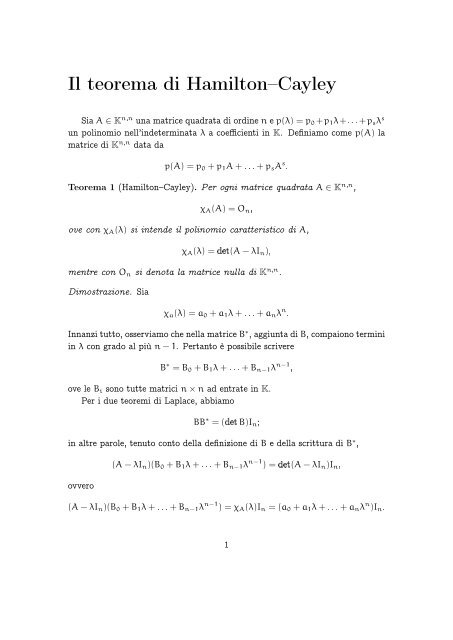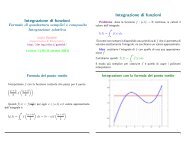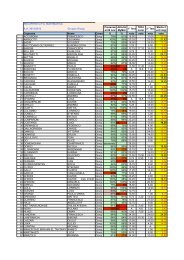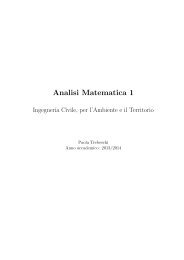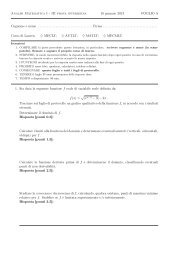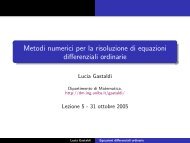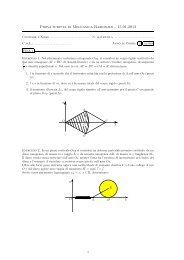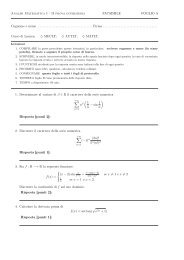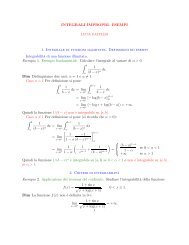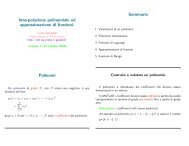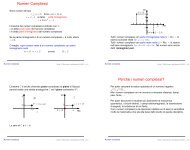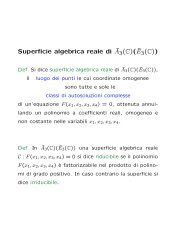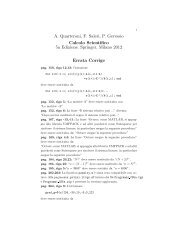Il teorema di Hamilton–Cayley
Il teorema di Hamilton–Cayley
Il teorema di Hamilton–Cayley
Create successful ePaper yourself
Turn your PDF publications into a flip-book with our unique Google optimized e-Paper software.
<strong>Il</strong> <strong>teorema</strong> <strong>di</strong> <strong>Hamilton–Cayley</strong><br />
Sia A ∈ K nn una matrice quadrata <strong>di</strong> or<strong>di</strong>ne n e p(λ) = p0 +p1λ+ +psλ s<br />
un polinomio nell’indeterminata λ a coefficienti in K. Definiamo come p(A) la<br />
matrice <strong>di</strong> K nn data da<br />
p(A) = p0 + p1A + + psA s <br />
Teorema 1 (<strong>Hamilton–Cayley</strong>). Per ogni matrice quadrata A ∈ K nn ,<br />
χA(A) = On<br />
ove con χA(λ) si intende il polinomio caratteristico <strong>di</strong> A,<br />
χA(λ) = (A − λIn)<br />
mentre con On si denota la matrice nulla <strong>di</strong> K nn .<br />
Dimostrazione. Sia<br />
χa(λ) = a0 + a1λ + + anλ n <br />
Innanzi tutto, osserviamo che nella matrice B ∗ , aggiunta <strong>di</strong> B, compaiono termini<br />
in λ con grado al più n − 1. Pertanto è possibile scrivere<br />
B ∗ = B0 + B1λ + + Bn−1λ n−1 <br />
ove le Bi sono tutte matrici n × n ad entrate in K.<br />
Per i due teoremi <strong>di</strong> Laplace, abbiamo<br />
BB ∗ = ( B)In;<br />
in altre parole, tenuto conto della definizione <strong>di</strong> B e della scrittura <strong>di</strong> B ∗ ,<br />
ovvero<br />
(A − λIn)(B0 + B1λ + + Bn−1λ n−1 ) = (A − λIn)In<br />
(A − λIn)(B0 + B1λ + + Bn−1λ n−1 ) = χA(λ)In = (a0 + a1λ + + anλ n )In<br />
1
Affinché la relazione sia sod<strong>di</strong>sfatta tutte le matrici che moltiplicano le varie<br />
potenze <strong>di</strong> λ a destra e a sinistra del segno <strong>di</strong> uguale devono coincidere, ovvero<br />
AB0 = a0In<br />
AB1 − B0 = a1In<br />
AB2 − B1 = a2In<br />
.<br />
ABn−1 − Bn−2 = an−1In−1<br />
−Bn−1 = anIn<br />
Moltiplicando le relazioni date per In, A, A 2 , , A n nell’or<strong>di</strong>ne si ottiene<br />
AB0 = a0In<br />
A 2 B1 − AB0 = a1A<br />
A 3 B2 − A 2 B1 = a2A 2<br />
. .<br />
AnBn−1 − An−1Bn−2 = an−1An−1 −A n Bn−1 = anA n ;<br />
sommando ora tutte queste equazioni fra loro si ha<br />
da cui segue il <strong>teorema</strong>.<br />
On = a0In + a1A + a2A 2 + + anA n = χA(A)<br />
Corollario 1. Data una matrice A ∈ K nn , l’insieme<br />
è linearmente <strong>di</strong>pendente.<br />
{A 0 = I A A 2 A n }<br />
In<strong>di</strong>cheremo con il simbolo K[x] l’insieme <strong>di</strong> tutti i polinomi nell’indeterminata<br />
x a coefficienti in un campo K. Tale insieme è dotato della struttura <strong>di</strong><br />
spazio vettoriale ma non è finitamente generato.<br />
Rammentiamo che un campo K è algebricamente chiuso se ogni polinomio<br />
f(x) ∈ K[x] con f(x) 1 ammette almeno una ra<strong>di</strong>ce in K. In particolare,<br />
questo è equivalente ad asserire che ogni polinomio <strong>di</strong> K[x] si può scrivere come<br />
prodotto <strong>di</strong> polinomi <strong>di</strong> grado 1, tutti appartenenti a K[x] stesso. Un esempio<br />
<strong>di</strong> campo algebricamente chiuso è il campo complesso C.<br />
2<br />
.
Teorema 2. Sia f(x) ∈ C[x] un polinomio tale che f(0) = 0. Allora, per ogni<br />
intero r > 0 esiste un polinomio g(x) ∈ C[x] tale che g(x) r − x è <strong>di</strong>visibile<br />
per f(x).<br />
Corollario 2. Sia A ∈ (n C). Allora, esiste una matrice T ∈ (n C)<br />
tale che<br />
T 2 = A<br />
Dimostrazione. Per il Teorema 2, con f(x) = χA(x) ed r = 2, esistono due<br />
polinomi g(x) h(x) ∈ C[x] tali che<br />
g(x) 2 − x = χA(x)h(x)<br />
Sostituendo ad x la matrice A ed osservando che per il Teorema 1 χA(A) = On,<br />
si ha<br />
g(A) 2 − A = On<br />
cioè<br />
A = g(A) 2 <br />
Ponendo T = g(A) si ottiene il risultato.<br />
<strong>Il</strong> corollario precedente è vero qualora si sostituisca C con un qualsiasi campo<br />
algebricamente chiuso <strong>di</strong> caratteristica 0.<br />
Referenze<br />
W.V.D Hodge, D. Pedoe, Methods of algebraic geometry, Volume 1, Cambridge<br />
University Press (1953).<br />
3


